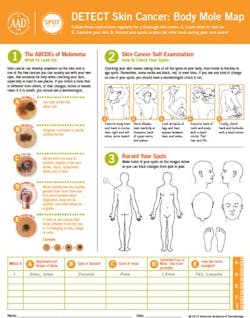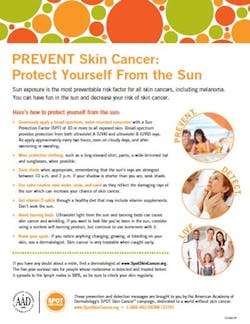On July 29, the Office of the Surgeon General released its Call to Action to Prevent Skin Cancer.(1) This type of cancer is a major public health concern, and there is a need for partners in the effort to prevent and treat this disease. The goal of the call to action is to increase awareness of skin cancer and to call for actions to reduce its risk.
Prevention and early detection is vital for any cancer. You can download a printable Body Map and Self-Examination Schedule to keep track of any spots that you notice on your body. On the first self-exam, make a dot corresponding to the location on your skin of each freckle, mole, birthmark, bump, sore, scab, or scaly patch. Draw a line out to the margin and indicate its approximate size and color, and the date. For each exam after that, find the spot on your skin that matches each dot, record the new date next to the old one, and note any change in size, color, or shape. Record any spots you did not see on last your examination. Use the Self-Examination Schedule to keep track of the dates on which you examined yourself. Indicate year, month, and day.(6)
It is said, “If you can spot it, you can stop it.”(7) In addition to early detection, prevention is vital. Avoid the sun, do not burn, avoid tanning booths, cover up with clothing and glasses, use a broad spectrum (UVA/UVB) sunscreen with an SPF of 15 or higher every day, apply 1 ounce (2 tablespoons) of sunscreen to your entire body 30 minutes before going outside, reapply every two hours or immediately after swimming or excessive sweating, keep babies out of the sun, perform a monthly self-exam, and seek a professional skin exam on a yearly basis.(7) It is important to know the ABCs of melanoma, the most deadly skin cancer.
Currently in the news, researchers at the Cockrell School of Engineering have designed an optical device that may reduce the number of biopsies by offering a fast, comprehensive, noninvasive, and low-cost solution to detect melanoma and other skin cancer lesions.(9) The device is a probe that combines three distinctive methods of using light to measure the properties of skin tissue. The device is in clinical trials, and the company is partnering with funding agencies and startup companies to help bring the device to dermatologists.
The left is a photo of the pen-sized 3-in-1 spectroscopy system. The right panel shows a view of the probel assembly with optical elements, such as filters, fibers and front lens. Credit: Review of Scientific Instruments/Eric Marple, EmVision LLC.(9)
Let’s do our part in prevention and early detection. While performing our head and neck examinations for oral cancer, take a look at any exposed scalp, behind the ears, and any accessible areas that may not be readily seen by the patient. In addition to our intraoral examination, check the face, ears, eyes, nose, head, and neck.(10)
Maria Perno Goldie, RDH, MS, is the editorial director of RDH eVillage FOCUS.
References
1. http://www.surgeongeneral.gov/library/calls/prevent-skin-cancer/index.html.
2. Lomas A, Leonardi-Bee J, Bath-Hextall F. A systematic review of worldwide incidence of nonmelanoma skin cancer. Br J Dermatol. 2012;166 (5):1069-1080.
3. U.S. Cancer Statistics Working Group. United States Cancer Statistics: 1999–2010 Incidence and Mortality Web-based report. Atlanta, GA: Centers for Disease Control and Prevention, U.S. Dept of Health and Human Services and National Cancer Institute, National Institutes of Health; 2013. http://www.cdc.gov/uscs. Accessed August 5, 2014.
4. Jemal A, Simard EP, Dorell C, et al. Annual report to the nation on the status of cancer, 1975–2009, featuring the burden and trends in human papillomavirus (HPV)-associated cancers and HPV vaccination coverage levels. J Natl Cancer Inst. 2013;105 (3):175-201.
5. International Agency for Research on Cancer, World Health Organization. IARC Monographs on the Evaluation of Carcinogenic Risks to Humans. Part D: Solar and Ultraviolet Radiation. 100D. Lyon, France: International Agency for Research on Cancer; 2012. http://monographs.iarc.fr/ENG/Monographs/vol100D/mono100D.pdf. Accessed August 5, 2014.
6. http://www.skincancer.org/Media/Default/File/File/webbodymap_1142011.pdf.
7. http://www.skincancer.org/skin-cancer-information/early-detection/if-you-can-spot-it-you-can-stop-it.
8. http://www.aad.org/File%20Library/Global%20navigation/For%20the%20public/SPOT/Body_Mole_Map_2013.pdf.
9. http://www.utexas.edu/news/2014/08/05/tunnell-cancer-detection-device/.
10. http://www.oralcancerfoundation.org/discovery-diagnosis/screening.php.
Additional Resources
1. http://www.skcin.org/sunSafetyAndPrevention/howToSpotSkinCancer.htm. The Karen Clifford Skin Cancer Charity. Raising Awareness Through Education Promoting Prevention & Early Detection Campaigning For Change.
2. http://www.cancer.org/cancer/cancercauses/sunanduvexposure/skincancerpreventionandearlydetection/. American Cancer Society.
3. http://time.com/3078213/the-kind-of-cancer-the-surgeon-general-wants-you-to-care-about/. TIME. The Kind of Cancer the Surgeon General Wants You To Care About, August 4, 2014.












